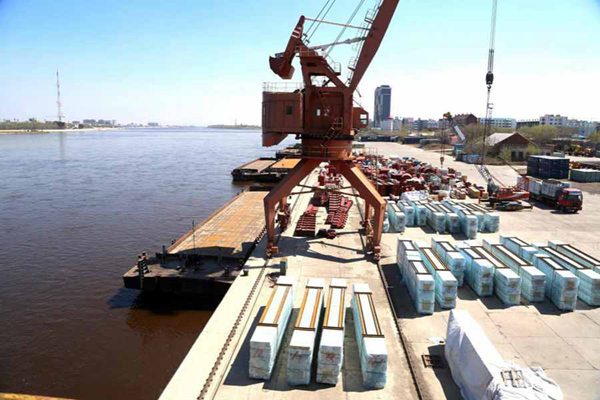
Photo shows a busy port in Heihe, a prefecture-level city on the south bank of Heilongjiang River. Bordering Russia, it is a key pivot connecting China with Russia.[Photo/People’s Daily]
Thanks to the favorable policy support from central government and measures taken by local administrations, the old industrial clusters in Northeast China have stepped out of shadow toward revitalization.
President Xi Jinping, while joining a panel discussion with deputies from northeast Liaoning province at the ongoing annual session of the National People’s Congress (NPC), stressed the importance of supply-side structural reform and reforms of State-owned companies, pointing a way for revitalization of the whole region.
The northeast, which consists of Liaoning, Jilin and Heilongjiang provinces, was among the first regions in China to become industrialized after the country was founded in 1949.
Back to those glorious days in 1950s, it was one of the major undertakers of the country’s 156 key projects. Its traditional industries included steel, automobile, shipbuilding and petroleum refining.
But when coming to the new century, the industrial development in the region failed to catch up the country’s pace to restructure economy, and its competitive edges were declined as a result. The clusters were even called a “rust belt” by some media.
In order to revive the industrial base, the central government and local administrations, in recent years, introduced a series of policies to increase investment, expand demand, and encourage innovation.
They also strove to build clean political ecology, improve business environment, release its endogenous energy, and introduce more capital and talents. In addition, in a bid to boost local real economy, the State-owned enterprises were selected as pioneers to implement the supply-side structural reform.
After rounds of endeavor, the regional economy has exhibited a new outlook since 2016. In the past year, Jilin province registered a GDP growth of 6.9 percent, while the increase of Heilongjiang province was estimated at around 6.1 percent.
Industrial electricity consumed by Liaoning province increased by 5.5 percent in the first two months of this year, and its general public budget revenue posted a double-digit growth as well.
